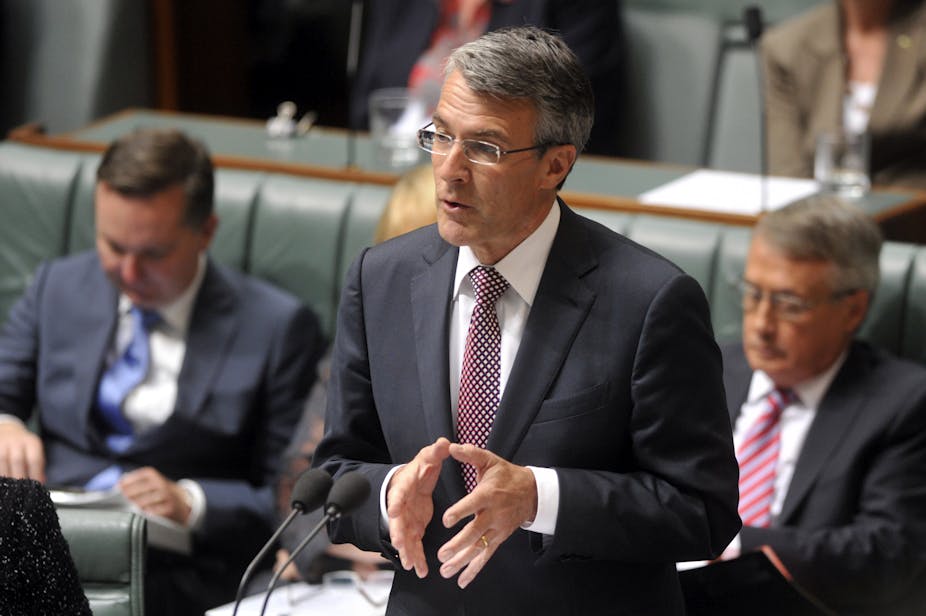Australia has been fortunate enough to see mostly honest governments. We’ve experienced neither the corruption of 1950s Italy nor the tyranny of 1970s Brazil. We are not, however, without our issues: give a government enough time and it is almost inevitable that corruption or serious wrongdoing will arise.
The institutional corruption of the Bjelke-Petersen government in Queensland showed this. This was followed by the Wood Royal Commission’s revelations of a thoroughly rotten NSW police force.
Currently, the Reserve Bank is embroiled in the nation’s biggest bribery scandal through its subsidiary Securency. The Gillard government’s announcement of a royal commission on child sexual abuse was a response to mounting evidence, including allegations of police collusion. These patterns of wrongdoing repeat.
Whistleblowing provides one system to reveal such serious wrongdoing. Done properly, it creates a method of improving integrity in government. Importantly it also prevents a small problem turning into a full scale catastrophe. As an example, no government can be sure that every person they hire will be honest: whistleblowing provides a fail-safe for this.
Last month, federal attorney-general Mark Dreyfus released proposed legislation designed to protect whistleblowers. However, while a step in the right direction, the bill fails to do so in important situations.

Politicians
The bill won’t protect people from making disclosures about the conduct of ministers (including the prime minister), the Speaker of the House of Representatives and the President of the Senate in many circumstances.
Clearly this is an utterly self-interested move by politicians and ought to be changed.
Intelligence agencies
The bill has exclusions for intelligence agencies and the use of intelligence information that result in whistleblowers effectively not being protected in a range of circumstances.
Intelligence agencies and their information must be included exactly because there is so little transparency around them. Such agencies employ people who seek to serve the public, but like the NSW police force in the early 1990s, it is possible pervasive corruption may erupt at some point. Given the far-reaching powers gifted to these agencies, it is vital corruption is stamped out early.
One could argue that the intensive screening processes used by such agencies would provide an effective fail-safe but as we saw in 2011, it too can fail. The Defence Security Authority pushed through thousands of falsified security checks on would-be employees, including top secret level clearances sent to ASIO.
How do we know about this major systems failure today? Three whistleblowers went to the media – after they unsuccessfully raised questions about the serious wrongdoing internally and were bullied for it. The initial failure of the fail-safe, and the bullying of whistleblowers that followed, illustrates why intelligence agencies cannot be excluded from this bill.
The media
Protection for those going to the media must also be better defined - and provide more solid ground to whistleblowers.
Most whistleblowers simply want to stop the wrongdoing. However, corruption may be systemic – from the bottom all the way to the top – making revealing the wrongdoing difficult or even dangerous. The media may be the only safe option to effect change.
There is strong public support among Australians for protecting whistleblowers and for permitting whistleblowers to go to the media. According to a 2012 Newspoll commissioned by our research team, 87% of Australians support whistleblowers being able to turn to the media, even if it means revealing inside information to do so.
The process
Whistleblowers need to know very specifically when they are protected if they are to make the hard choice to reveal wrongdoing. The bill is vague in this regard. Research shows they do pay attention to formal paths set up for them so these need to be defined in far more detail.
The bill as proposed might not have protected whistleblowers revealing some of the misconduct from a scandal such as WA Inc Royal Commission were it at a federal level. This is one way to test the bill’s robustness - and as currently drafted, the bill fails.
The current bill has two main benchmarks for comparison: Andrew Wilkie’s private members bill and the ACT whistleblowing legislation passed in August last year. Both set a high standard for any new legislation and both are better than Dreyfus’ current proposed bill.

However, the attorney-general has the opportunity to not only raise the bill to their standard, but to take the new bill a step further still. This could be achieved by providing financial support for the whistleblower. In Britain, often held up as being a zenith of whistleblowing legislation, the high cost of legal defense has become a point of failure.
The new Australian bill could remedy this by a creating a defence fund specifically for whistleblower cases in the public interest. It could be self-funding by taking a percentage of any savings to the public purse realised as a result of whistleblowing.
Such a scheme would be a public interest adaption of the US qui tam legal remedies. Rather than the whistleblower receiving a large cheque (potentially creating the wrong motivation), they would receive free or subsidised legal support via the fund.
Whistleblowing is a core freedom of expression issue. It is critical we properly protect whistleblowers brave enough to step forward. It is not possible to ensure that everyone elected to or employed by government is angelic. But with good whistleblowing laws we can ensure that our collective better angels are watching out for the integrity of our public institutions.

